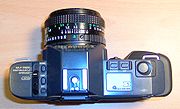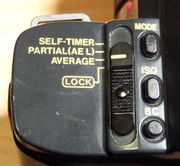
Canon T70
Encyclopedia
The Canon T70 was a 35mm
FD-mount
single-lens reflex camera
introduced in April 1984 as the second in Canon
's T series
. The T70 started with the concepts explored in 1983's T50
, took them further, and applied them to a more sophisticated camera. While the Program AE-only T50 was intended as a beginner's camera, the T70 gave the photographer a lot more control over the camera's operation while keeping the T-series philosophy of simplicity in control and operation intact.
(BR-1225 or CR-1220) was used to store user settings; the batteries lasted for about five years, and had to be replaced by a technician, since replacing them required partial dismantling of the camera body.
 The T70 used a LCD mounted on the top of the right-hand side of the camera as a major component of its user interface. Two buttons above the display labelled 'UP' and 'DOWN' adjusted the selected parameter and the results were shown on the LCD. Buttons on the right-hand top of the camera selected the parameter to be modified.
The T70 used a LCD mounted on the top of the right-hand side of the camera as a major component of its user interface. Two buttons above the display labelled 'UP' and 'DOWN' adjusted the selected parameter and the results were shown on the LCD. Buttons on the right-hand top of the camera selected the parameter to be modified.
 The T70 included two different through-the-lens
The T70 included two different through-the-lens
metering methods; both used a silicon
photocell housed above the viewfinder
eyepiece. Center-weighted average metering was the standard metering method, averaging over the whole frame with a slight preference towards the center of the frame, where the main subject is most likely to be. With strongly backlit scenes, or ones where the subject is spotlit against a dark background, center-weighted averaging produces underexposure or overexposure, respectively. For such situations, the T70 also supported selective area metering, which metered only the center 11% of the frame. The metering mode was selected by a sliding switch on the top left-hand side of the camera (from the photographer's perspective). This switch also selected self-timer mode and had a Lock position.
, Everett Ortner said that the T70 "could be...too good for amateurs. It is certainly far removed from those other technological wonders designed for amateurs". He praised the high degree of control, coupled with automation, that the T70 allows photographers to use, reducing "the role of the camera from that of master to servant."
135 film
The term 135 was introduced by Kodak in 1934 as a designation for cartridge film wide, specifically for still photography. It quickly grew in popularity, surpassing 120 film by the late 1960s to become the most popular photographic film format...
FD-mount
Canon FD
The Canon FD lens mount is a physical standard for connecting a photographic lens to a single-lens reflex camera body. The standard was developed by Canon of Japan and was introduced in March 1971 with the Canon F-1 camera. It was the primary Canon SLR lens mounting system until 1987 when the...
single-lens reflex camera
Single-lens reflex camera
A single-lens reflex camera is a camera that typically uses a semi-automatic moving mirror system that permits the photographer to see exactly what will be captured by the film or digital imaging system, as opposed to pre-SLR cameras where the view through the viewfinder could be significantly...
introduced in April 1984 as the second in Canon
Canon Inc.
is a Japanese multinational corporation that specialises in the manufacture of imaging and optical products, including cameras, camcorders, photocopiers, steppers and computer printers. Its headquarters are located in Ōta, Tokyo, Japan.-Origins:...
's T series
Canon T series
Canon's T series is Canon's final series of manual focus 35 mm single lens reflex cameras. The first camera, the T50, was introduced in March 1983 while the final camera, the T60, was released in April 1990. All have a Canon FD lens mount compatible with Canon's extensive range of manual-focus...
. The T70 started with the concepts explored in 1983's T50
Canon T50
The Canon T50, introduced in March 1983 and discontinued in December 1989, was the first in Canon's new T series of 35mm single-lens reflex cameras compatible with Canon's FD lens mount. SLR sales were falling in 1983 from the market's 1981 peak, and Canon chose to try greater automation to revive...
, took them further, and applied them to a more sophisticated camera. While the Program AE-only T50 was intended as a beginner's camera, the T70 gave the photographer a lot more control over the camera's operation while keeping the T-series philosophy of simplicity in control and operation intact.
Power
All film transport on the T70 was powered—loading, advance and rewind. The continuous shooting rate, at 0.7 frames per second, was slower than rival motor drives, but the drive was nonetheless faster than most people could manually wind. To load the camera, the photographer simply had to pull the film leader out to an orange mark and close the back—the camera did the rest, loading the leader onto the spool, and advancing to the first frame automatically. All powered camera functions drew on two AA batteries in the grip. A built-in lithium batteryLithium battery
Lithium batteries are disposable batteries that have lithium metal or lithium compounds as an anode. Depending on the design and chemical compounds used, lithium cells can produce voltages from 1.5 V to about 3.7 V, over twice the voltage of an ordinary zinc–carbon battery or alkaline battery...
(BR-1225 or CR-1220) was used to store user settings; the batteries lasted for about five years, and had to be replaced by a technician, since replacing them required partial dismantling of the camera body.
Controls

Metering

Through-the-lens
Through-the-lens metering is a photographic term describing a feature of cameras capable of measuring light levels in a scene through their taking lenses, as opposed to a separate metering window...
metering methods; both used a silicon
Silicon
Silicon is a chemical element with the symbol Si and atomic number 14. A tetravalent metalloid, it is less reactive than its chemical analog carbon, the nonmetal directly above it in the periodic table, but more reactive than germanium, the metalloid directly below it in the table...
photocell housed above the viewfinder
Viewfinder
In photography, a viewfinder is what the photographer looks through to compose, and in many cases to focus, the picture. Most viewfinders are separate, and suffer parallax, while the single-lens reflex camera lets the viewfinder use the main optical system. Viewfinders are used in many cameras of...
eyepiece. Center-weighted average metering was the standard metering method, averaging over the whole frame with a slight preference towards the center of the frame, where the main subject is most likely to be. With strongly backlit scenes, or ones where the subject is spotlit against a dark background, center-weighted averaging produces underexposure or overexposure, respectively. For such situations, the T70 also supported selective area metering, which metered only the center 11% of the frame. The metering mode was selected by a sliding switch on the top left-hand side of the camera (from the photographer's perspective). This switch also selected self-timer mode and had a Lock position.
Exposure modes
The T70 supported eight different exposure modes. These were:- Program AE (autoexposure). In this standard mode, the camera judges the shutter speed and aperture for average photographic scenes.
- Wide Program AE. Here, the camera is biased towards choosing narrow apertures for greater depth of field, most often useful with wide-angle lenses.
- Tele Program AE. Here, the camera is biased towards choosing wider apertures for narrow depth of field and fast shutter speeds, most useful with telephoto lenses.
- Shutter-priority AE. Here, the user selects the shutter speed and the camera chooses the correct aperture.
- Programmed flash AE. This is designed to work with the Speedlite 277T dedicated flash unit.
- Electronic flash AE. For flash exposures with non-dedicated flash units.
- Manual. Here, the photographer chooses both aperture and shutter speed.
- Stopped-down AE. For use with older FL-mountCanon FLCanon FL refers to a lens mount standard for 35mm single-lens reflex cameras from Canon. It was introduced in April 1964 with the Canon FX camera, replacing the previous Canon R mount. It was in turn replaced in 1971 by the Canon FD lens mount...
lenses that do not support open-aperture metering. Also for use with macro photographyMacro photographyMacrophotography is close-up photography, usually of very small subjects. Classically a macrophotograph is one in which the size of the subject on the negative is greater than life size. However in modern use it refers to a finished photograph of a subject at greater than life size...
attachments such as extension tubes and bellows, and for using non-Canon lenses with an adaptor. Cannot be selected with an FD lens attached.
Data back
A dedicated Command Back 70 supported date and data imprinting as well as time exposures, to take a photograph at a programmed time, and to take time-lapse photos at programmed intervals. The shutter of the T70 was not battery dependent during bulb exposures, and was one reason why the command back could support timed exposures of several hours duration.Reception
When it was introduced, the Canon T70 was considered technologically advanced compared to other SLR cameras. Reviewing the camera in Popular SciencePopular Science
Popular Science is an American monthly magazine founded in 1872 carrying articles for the general reader on science and technology subjects. Popular Science has won over 58 awards, including the ASME awards for its journalistic excellence in both 2003 and 2004...
, Everett Ortner said that the T70 "could be...too good for amateurs. It is certainly far removed from those other technological wonders designed for amateurs". He praised the high degree of control, coupled with automation, that the T70 allows photographers to use, reducing "the role of the camera from that of master to servant."
External links
- Canon T70. From Canon's online Camera Museum.
- Photography in Malaysia (2000). Canon T70 Camera. Retrieved on October 20, 2005.
- Canon Inc.Canon Inc.is a Japanese multinational corporation that specialises in the manufacture of imaging and optical products, including cameras, camcorders, photocopiers, steppers and computer printers. Its headquarters are located in Ōta, Tokyo, Japan.-Origins:...
(1984). Canon T70 User Manual. Retrieved from the Canon FD Documentation Project on October 20, 2005. - Canon Inc.Canon Inc.is a Japanese multinational corporation that specialises in the manufacture of imaging and optical products, including cameras, camcorders, photocopiers, steppers and computer printers. Its headquarters are located in Ōta, Tokyo, Japan.-Origins:...
(1984). Canon T70 Service Manual. Retrieved from the Canon FD Documentation Project on October 20, 2005.

